
electricwood
-
Posts
26 -
Joined
-
Last visited
Content Type
Profiles
News and Information
Tutorials
Product Reviews
Supplier Listings
Articles
Guitar Of The Month
Links and Resources
Forums
Gallery
Downloads
Posts posted by electricwood
-
-
My newest builds have figured redwood tops, and I was curious about your opinions/experiences with finishing this wood. I have used Tru-Oil, shellac, spray waterbase, and a wipe on poly in the past. I would appreciate your input.
Regards.
-
I´m interested in that neck. Zebrawood as a neck? Haven´t heard of that, yet

I did a laminated zebrawood neck on the 7_B. I will say that you must be very careful and use stable pieces (stay clear of riftsawn). I usually cut zebra wood up into neck blank sized pieces and let it sit for a few weeks to see if it moves.
It makes for a very nice neck if it is stable. If it is not... well happy twisting.
Thanks everyone for the help. I will post a pic of the neck, etc. The zebrawood is quartersawn, and I am hoping for the best. Please check the pic and comment.

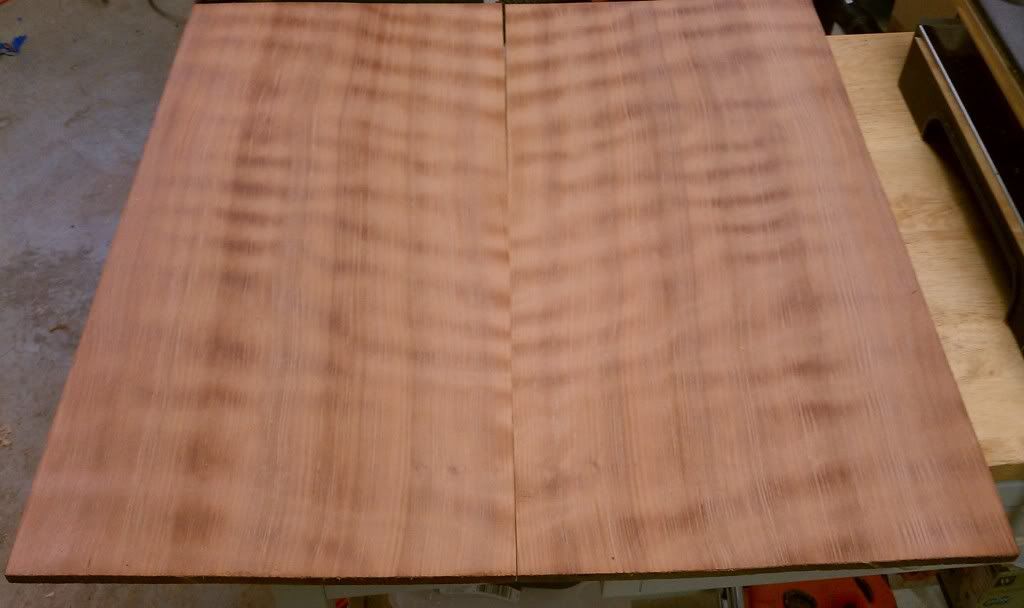
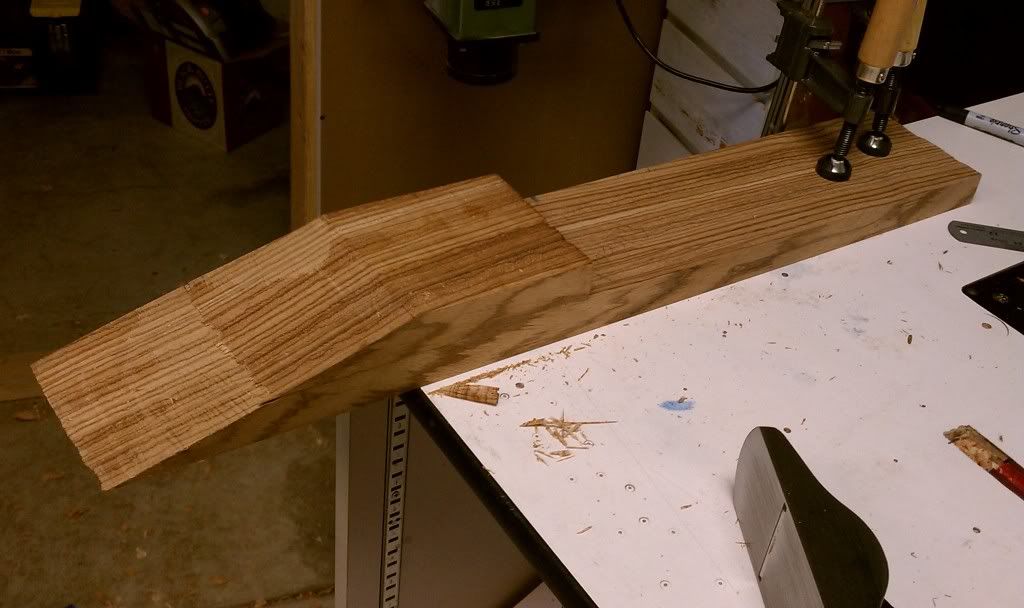
More work has been done and it is time to bring this up to date. As you can see, channel sin the body has been drilled out for wiring to the front picup and the toggle switch. As I am not using a pickguard, these channels are run under the curly redwood top. The control cavity has been partially routed, but not all the way through, as I am still determining the overall size of the control cavity. With the 4 pots andthe PA-2 switch and board, it will be tight and I always thought the firebird's volume pots were too close together. Anyway, the customer decided on the orientation of the grain of the redwood relative to the body (th "point" aims towards the neck. Some picture of the body, template, top, and the glue up. The glue up went well and the total body thickness is exactly 1 3/4".



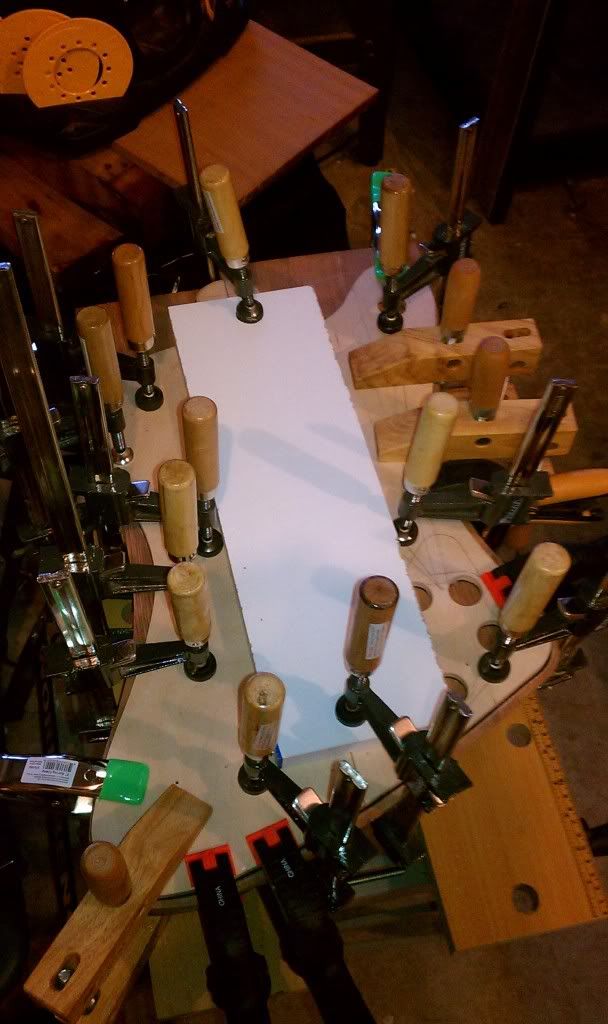
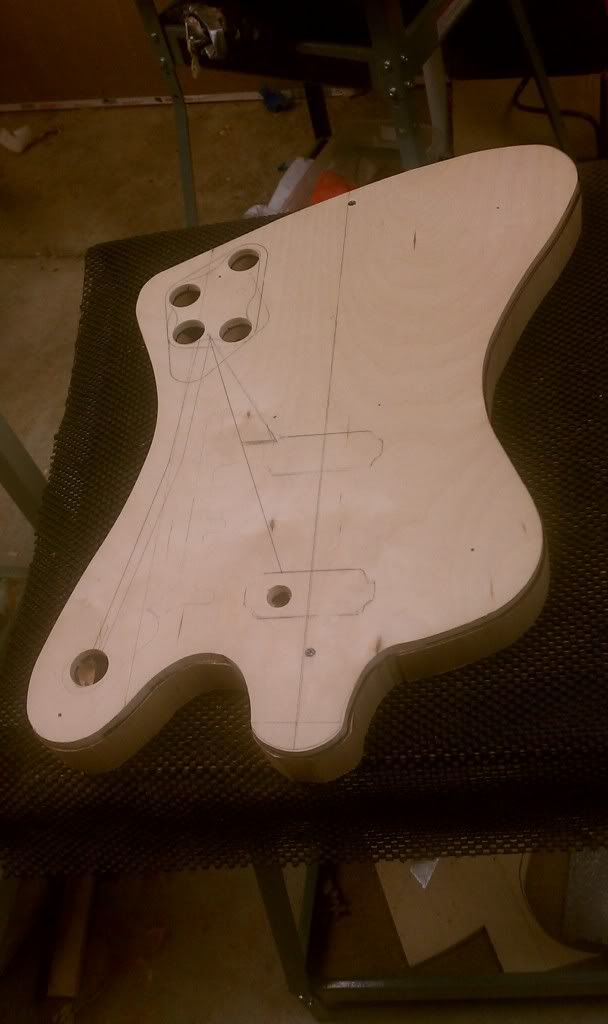
-
Yup, don't get me wrong, just wanted to push that there are IMHO better ways to do this job.
Thanks, everyone! I have ordered an unradiused board through LMII--I can use the radiused for another build. I will NOT be fretting/binding Gibson style with the "nibs", but rather bringing the fret top over the binding. Any tips would be appreciated.
So, Binding before gluing to the neck, eh? I was hoping to mount the FB, then use a router table and bit to take away the excess for binding. I'd like to heard agruments both ways...
-
IMHO the Gotoh Floyd performs just as well as an original Floyd, I use either a Floyd or Gotoh on my custom guitars and all i ever offer my customers are these 2 type of fulcrum type trems. For others a Kahler is another quality trem and to be honest my personal favourite, hope it helps

But what about replacement parts, such as saddles and blocks, etc?
-
Yeah. Thats the kind of job which should make you start to question why you're radiusing the fingerboard before sticking it on the neck! ;-)
It was already radiused by stewmac.
-
Has anyone needed to get replacement parts for their gotoh floyd besides the arm? I like these trems very much, but am more inclined to go the schaller/original floyd route as I can source the parts very easily. I mean saddles, string blocks, etc.
-
I´m interested in that neck. Zebrawood as a neck? Haven´t heard of that, yet

I did a laminated zebrawood neck on the 7_B. I will say that you must be very careful and use stable pieces (stay clear of riftsawn). I usually cut zebra wood up into neck blank sized pieces and let it sit for a few weeks to see if it moves.
It makes for a very nice neck if it is stable. If it is not... well happy twisting.
Thanks everyone for the help. I will post a pic of the neck, etc. The zebrawood is quartersawn, and I am hoping for the best. Please check the pic and comment.



-
I´m interested in that neck. Zebrawood as a neck? Haven´t heard of that, yet

I did a laminated zebrawood neck on the 7_B. I will say that you must be very careful and use stable pieces (stay clear of riftsawn). I usually cut zebra wood up into neck blank sized pieces and let it sit for a few weeks to see if it moves.
It makes for a very nice neck if it is stable. If it is not... well happy twisting.
Thanks everyone for the help. I will post a pic of the neck, etc. The zebrawood is quartersawn, and I am hoping for the best. Please check the pic and comment.
-
Can some one please tell me how to post pictures from Photobucket? I cannot remember how.
-
body template:
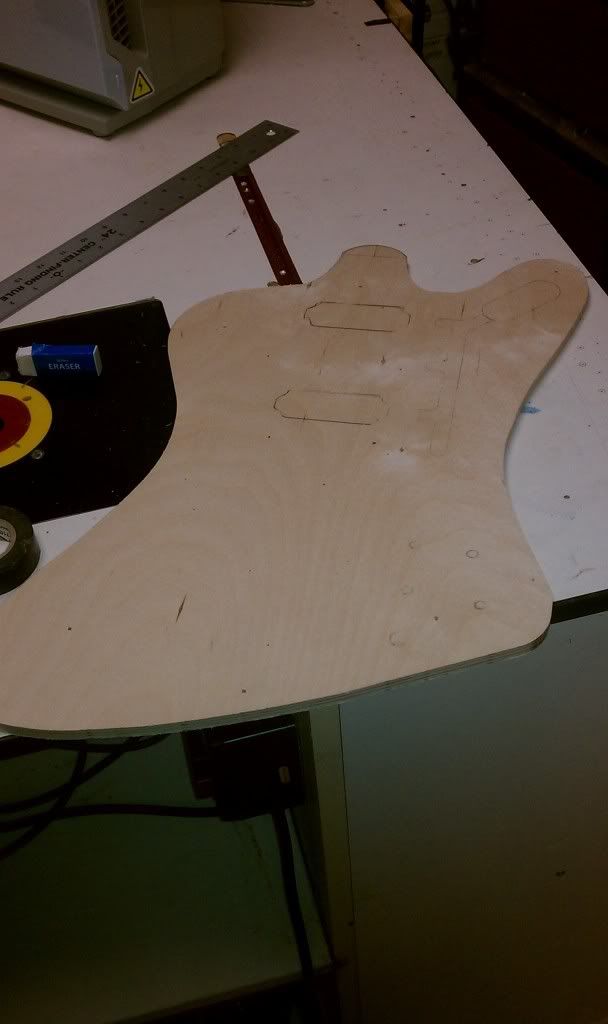


body wood:

-
This newest build is a customer spec-d "Firebird", with a thicker body (no "steps"), ebony board, and set neck rather than neck thru construction. The body shape is standard, with a conventional (but custom) 3x3 headstock.
The materials:
Mahoghany back
curly redwood top
quartersawn zebrawood neck
ebony board (no inlay)
pearloid binding throughout
Electronics:
EMG 89 & 81
2 vol 2 tone (one a push pull for the 89 and the other a Shadow "kill pot")
EMG PA-2 preamp booster
Hardware:
All chrome
pickup rings
Hipshot O ring knobs
Dunlop recessed straplocks
Tone pros Nahville (string thru)
misc:
Earvana nut
medium jumbo frets
2 way truss rod
-
I use a tapering jig to trim the fretboard first to allow for the thickness of the binding. Then glue the fretboard in place, apply the binding, then profile and carve the neck. It's worked pretty well on the 2 I've done so far.
Peace,
Mark
Mark, Thanks!
A tapering jig on your tablesaw? This fretboard is ebony, so I am afraid of chipping.
-
I prefer to radius a fingerboard after it's on the neck
+1 on that. I glue the fretboard onto the neck blank, bindings already attached, trim the blank to the right taper, and carve the neck as close to the final shape as possible before i radius the fretboard
Thanks again! Unfortunately, I have a pre-radiused fretboard picked out by the customer. Another member said to taper cut the board first, gue on the binding, glue to the neck blank and use the fretboard as the bearing guide when trimming the neck to size. What do you all think?
-
I am binding a neck for the first time (frets over the binding--not Gibson style)and I am set on my fret tang clipper etc, I am more concerned with when to apply the binding and how to get the measurements correct.
This will be a Gibson scale neck that is 1 11/16 nut width. The fretboard has already been radiused to 12" (prepurchased that way). Do I trim the fretboard to sixe first, then bind and then glue to the neck or glue it to the neck and then route the binding channel with a rabetting bit or some combination thereof? I have only made unbound necks thus far, so any help is appreciated.
-
I am binding a neck for the first time (frets over the binding--not Gibson style)and I am set on my fret tang clipper etc, I am more concerned with when to apply the binding and how to get the measurements correct.
This will be a Gibson scale neck that is 1 11/6 nut width. The fretboard has already been radiused to 12" (prepurchased that way). Do I trim the fretboard to sixe first, then bind and then glue to the neck or glue it to the neck and then route the binding channel with a rabetting bit or some combination thereof? I have only made ynbound necks thus far, so any help is appreciated.
-
Definitely drool worthy.

Love the Gumby headstock, it looks great with the traditional-ish body .
Very simple, yet it looks like its got a huge tone. I think of Molly Hatchet when I see P-90's .
Craftsmanship looks to be top notch, - and I knew you meant Mahogany neck, I was just funnin.

My only criticism is that you used Dimarzio strap locks, which I hate. No plastic clips for me thanks ! lol ( I know, I know , Steve Vai uses them.... )
I just like the ones I use because you can still use a normal strap if you want to.........
You definitely made a beautiful V tho.

I played a gig and then changed my mind about the strap, as well. I do love the cliplocks but they didn't look right on this one. I pieced together straplocks using washers, etc. and a 3" wide leather strap. It look smuch better now and balances perfectly. The only problem with dunlop or schaller straplocks and a strap attachment at the neck heel is I hate how they poke into my stomach or belt. I need straplocks because I am clumsy. I will post pics of what I mean.
I also changed the locking tuners to sperzel. I went cheap, then went back

-
When Michael Schenker is on, he is awe-inspiring. Too bad that isn't often. Technique/tone/feel. 2nd could be Gary Moore--very under-rated.
I also admire Uli Jon Roth, but have never liked his tone. Certainly Lukather and Petrucci for versatility.
-
This bass is named "Bronwen" after the customer's daughter. He and I designed the shape and specified the electronics and switching. In summary:
5 string bass tuned E-A-D-G-C
35" scale
24 fret ebony board from LMII
Dunlop 6100 fretwire
quilt maple top and headplate
sapele back
bolivian rosewood neck
double action trussrod
SS support beams in the neck from Warmoth
Bartolini soapbar pickups
1 500k volume & 3 way toggle
corian nut
Dunlop recessed straplocks
Body and headstock finished in wipe on poly
neck in tung oil blend
Thanks for your consideration.
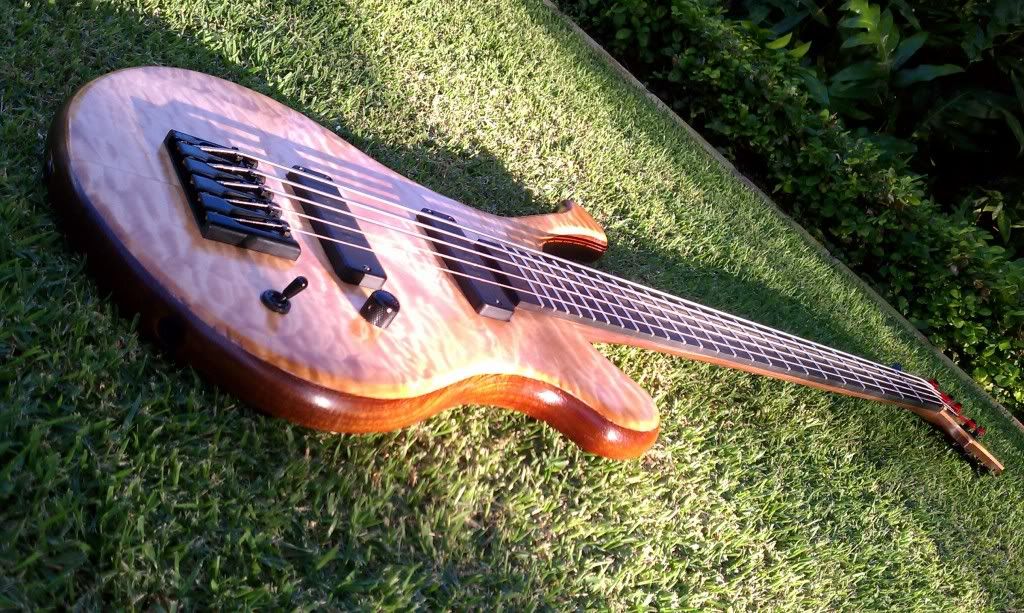
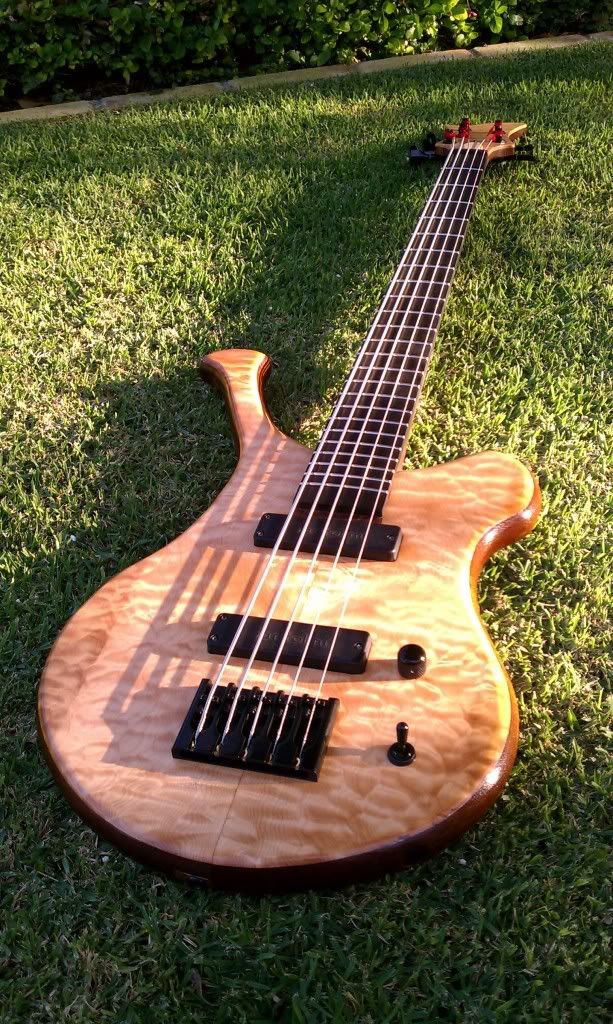


-
Thanks for the responses. I am really leaning toward a natural amber hue, rootbeer or green. I am worried that the rootbeer will be too similar to the fretboard color.
-
A two bodied V? Cool.....
Thanks for catching that...black limba/korina body, mahogany neck.
What do you think otherwise?
-
This is my 5th build. I have started and stopped it several times over the last 4 years. The back is sapele with a quilt maple top, a bois de rose fretboard, and Gold EVO fretwire. The 7 string TOM is a gold tone pros and the electronics will be 2 dimarzios (Tone Zone and PAF7--both black coils) with 2V 1T, a three way, and push pulls for splitting. Tuners will be gold locking grovers. The neck is a 3 price maple/mah/maple with a chunk of quilt maple scarfed in for a headstock. 22 frets on a 25 1/2" scale
I am at a point where I now need to decide on a stain. The maple edges will be clear for a PRS style "binding" and the back will be natural.
Any suggestions on a top color with gold fretwire and hardware and black pickups?
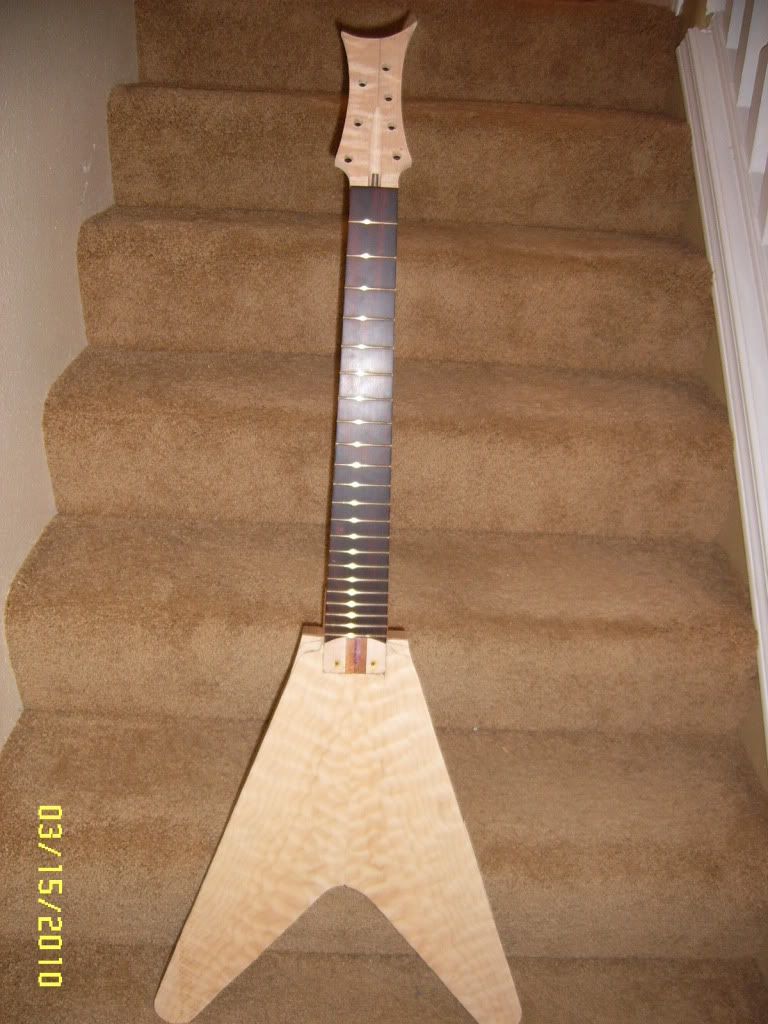
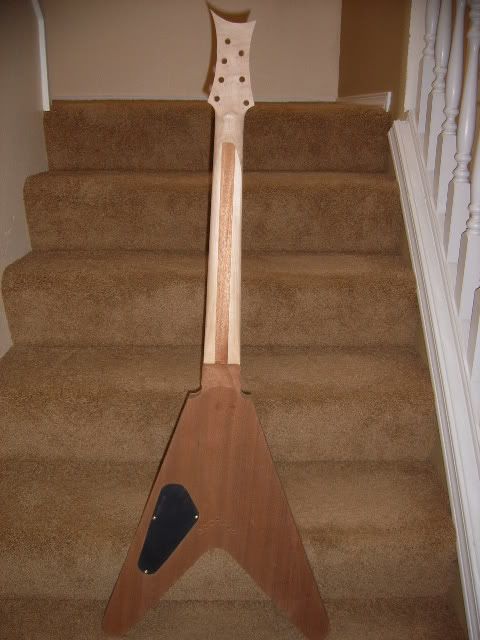
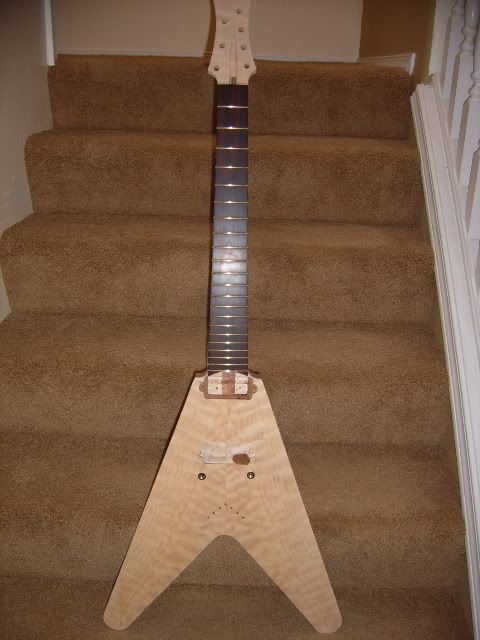
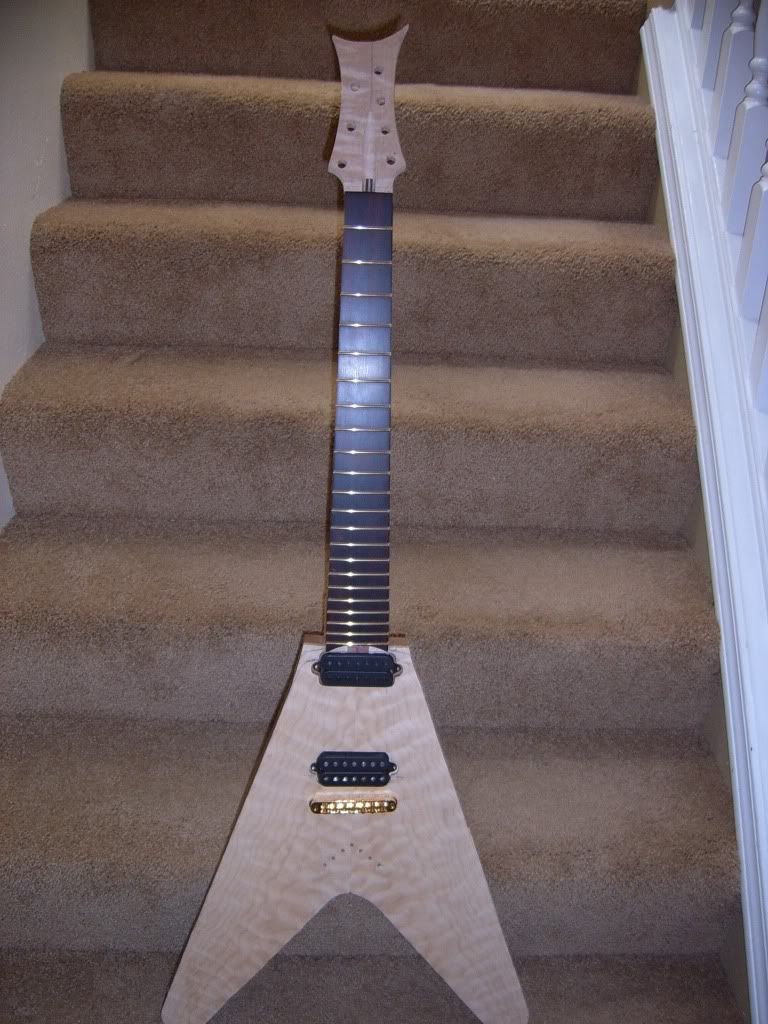
-
This is my 3rd build. Inspired by a Les Paul Jr., it has a wraparound bridge, a korina body, mahagony body, rosewood board and medium fretwire. I was going to use a dogear P90, but decided to try a Duncan P-Rails for added versatilty. Electronics are: volume and tone wired in the 50's "vintage" style with a 3 way mini toggle for selection between single coil/P90/humbucker. The other major stylistic change is 24 frets rather than 22 which allowed for a longer fingerboard/neck tenon.
Comments/advice/criticism appreciated.
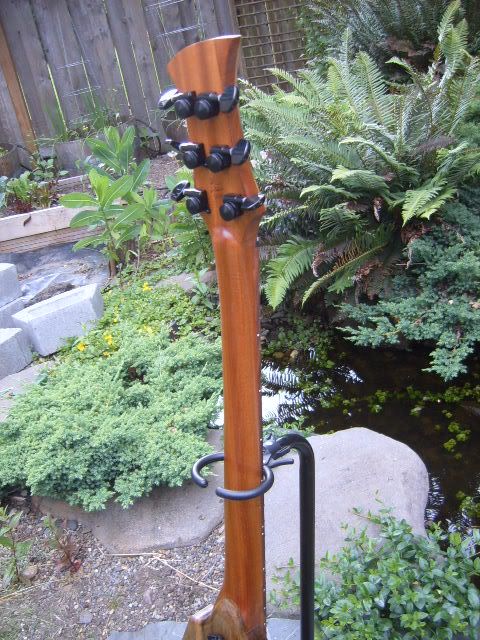
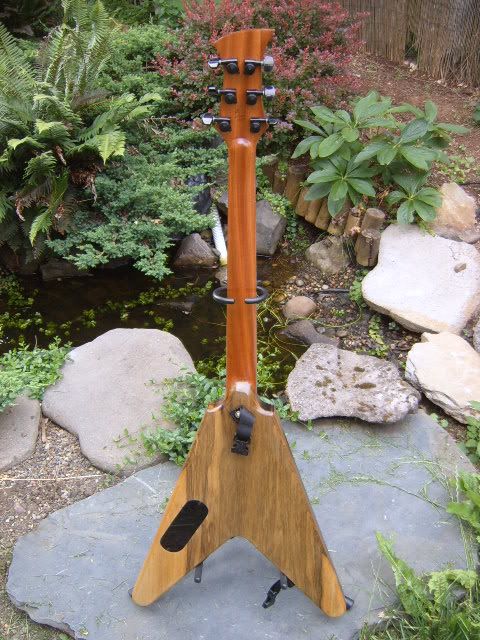

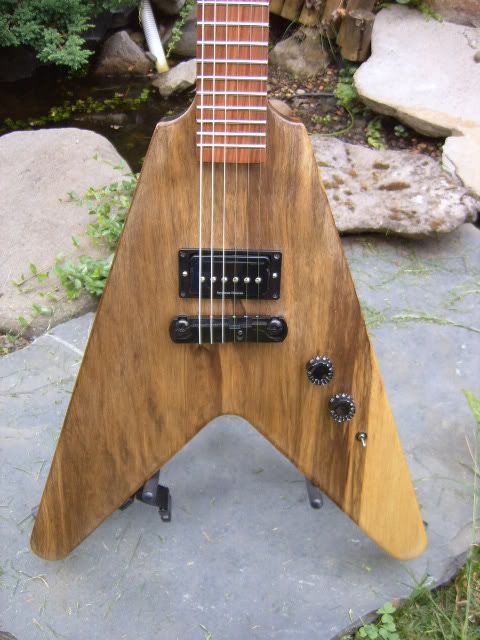
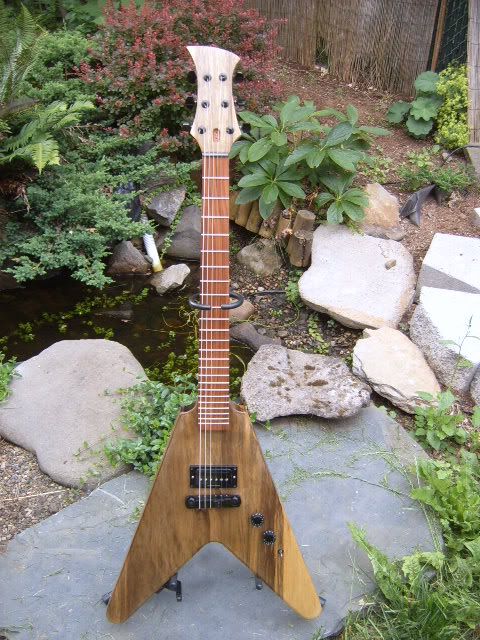
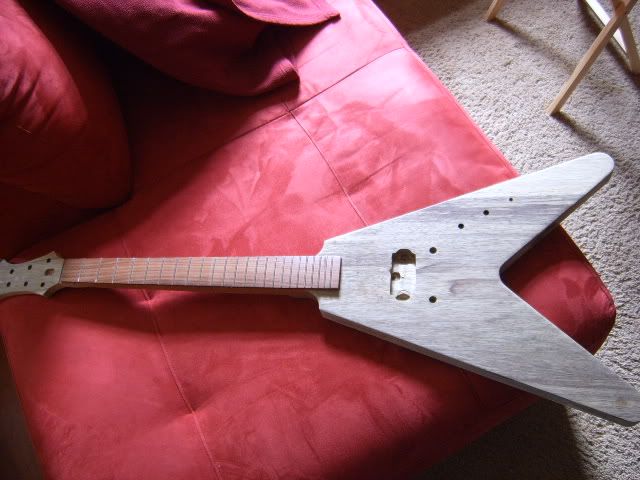

-
Looks great! What size roundover bit did you use on the top?
The thickness is about 1 1/2" so I used a 3/4" roundover moving slowly in a router table and a lot of handwork. The sapele is much harder than the maple, so a had a few chipout spots on the maple. I also had some issues with burning.
-
Looks great. That upper horn is too thin to match the rest of the design, but it's still quite nice !
so... a high C string. Any reason ?
Customer wants to solo and play high chords and melodies. He was inspired by the 5 string and piccolo basses popular in the 1970s.

Guitar Of The Month - November 2022
in Guitar Of The Month entry/poll archive
Posted · Edited by electricwood
My entry is a take on a Thunderbird bass with my own shape for the headstock which helped greatly with reducing "neck dive". It is part of a set (T-bird and F-bird) made per spec for a longtime friend, who plays in several bands. Standard woodshop and lutherie tools were used in my garage. I have been working on guitars for over 20 years but doing the occasional complete/from scratch build every few years. I started this in 2017.
scale: 34", med jumbo frets
set neck: 5 piece: maple/wenge/maple/wenge/maple with a rosewood board and pearloid dots. scarf joint. 1.5" nut width.
pickups: Bartolini
The body wood is Spanish Cedar with a figured redwood top. Binding is pearloid on the body and headstock. The electronics and truss rod covers are also pearloid. The matching "f-bird" will also have similar aesthetics and chrome hardware. The finish is "Aqua Coat" brand WB "lacquer". Neck finish is tru-oil so there is a difference in shade in the pictures
Hipshot bridge (a thing of beauty) and knobs.
The bass very light but still well balanced due to the smaller headstock and the heft of the hipshot bridge. It's sound is aggressively piano-like". The other members can name it what they want but he called me and said that the bass is "the cure for low T".
Thank you all in for the consideration. I welcome any questions and feedback.